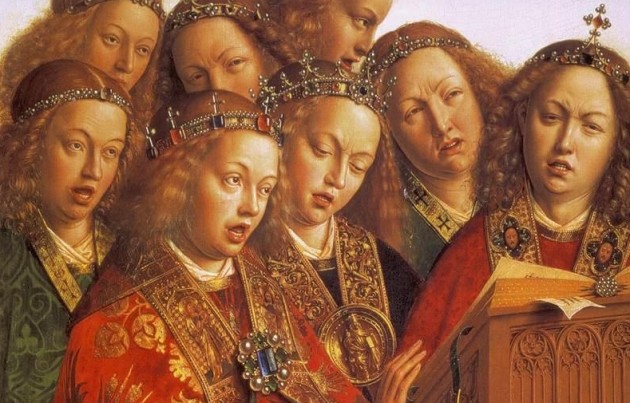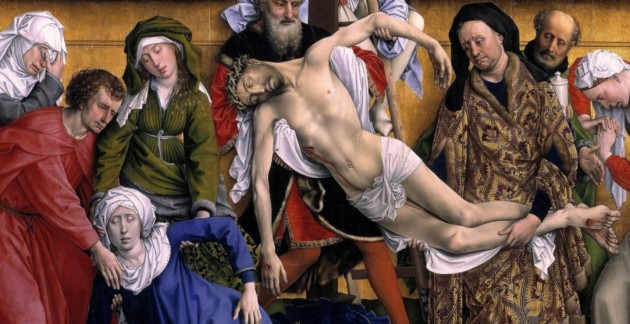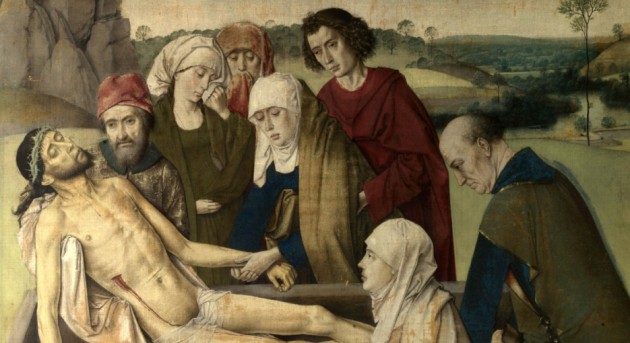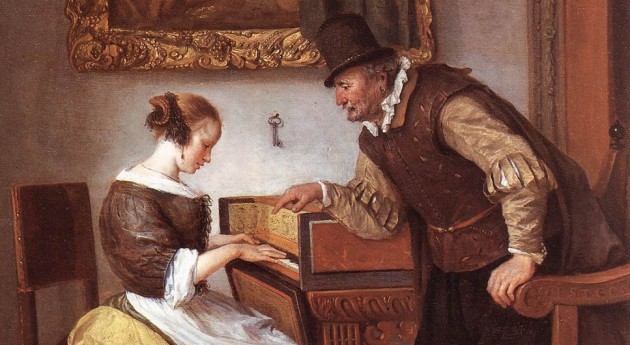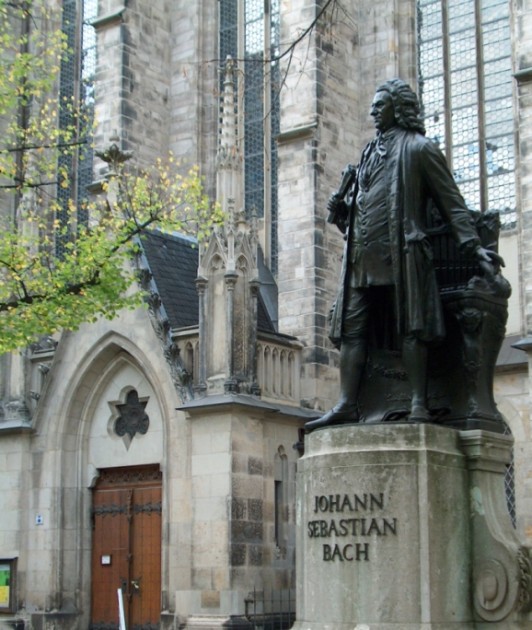Baroque Lobster
“In Bach the vital cells of music are united as the world is in God.” – Gustav Mahler
Bach’s choral music is, for me, his most entertaining and spiritually refreshing work. Bach was obliged to produce vast quantities of religious music during his long tenure as Leipzig’s leading composer. He evidently relished the task, because it gave him an opportunity to serve God through sound, as instructed by The Bible. Bach’s Mass in B Minor is quite simply one of the single greatest choral works ever composed, and as ever, I recommend listening to the whole thing, but if that’s too much work, you can just skip to the particularly good bits, which unsurprisingly accompany all the most joyful sections of the Latin text. I’ve picked out a few of them for you:
Mass in B Minor – Gloria in excelsis deo
Mass in B Minor – Cum Santo Spiritu
Mass in B Minor – Et resurrexit
Mass in B Minor – Et expecto
Mass in B Minor – Sanctus
Mass in B Minor – Osanna
Next up is the St. Matthew Passion, which sets the story of Christ’s final days to music, and is arguably his greatest work. The piece is about as close as Bach ever came to writing an opera, as it takes a related form known as an Oratorio. What’s the difference? Well, if you take an opera, get rid of the sets and the acting, change the subject from mythology to religion, put the musicians and the singers on stage together, and then replace dialogue with narration, you’ve got yourself an oratorio. The advantage of the oratorio is that it allows you to put in all kinds of choral effects that would seem contrived in the already ridiculous plot of an opera. In the St. Matthew Passion, a tenor plays the part of St. Matthew the Evangelist, filling in all the plot details from the Bible with recitatives. These sections are interspersed with chorales (short hymn-like tunes) sung by the whole choir, and arias – longer songs performed by four soloists (Soprano, Alto, Tenor and Bass) which are usually reflections on what has just happened in the story. For example, after Peter betrays Christ, there is a poignant aria which is concerned with forgiveness and mercy. If you listen to the full piece along with the lyrics, you can hear where Bach has used a wide range of musical effects to heighten the drama. For instance, whenever Jesus speaks, he has his own specific instrumental accompaniment, forming a musical “halo” which no other character is given. Bach also took advantage of the various crowd scenes in the story as a platform for intricate choral writing – when Christ is mocked, the choir let you hear their scornful voices; when the mob urges Pilate to crucify him, the choir bays for blood, and so on. Bach also used word-painting (making the music literally match the words) to brilliant effect. For example, after Christ dies, the low strings produce the earthquake mentioned in the text. Again, if you don’t have time for the whole piece, just listen to the choral sections which bookend the work, as well as a couple of the main arias:
Matthäus-Passion BWV 244, No. 1 – Chorus: Kommt, ihr Töchter, helft mir klagen (Come, ye daughters, help me lament)
Matthäus-Passion BWV 244, No. 39 – Alto aria: Erbarme dich (Have mercy)
Matthäus-Passion BWV 244, No. 65 – Bass aria: Mache dich mein herze rein (Make thyself clean, my heart)
Matthäus-Passion BWV 244, No. 68 – Chorus: Wir setzen uns mit Tränen nieder (We sit down in tears)
Honourable mentions also go to the jubilant Magnificat and the cheerful Christmas Oratorio, which is mercifully free of jingle bells. I’ve left it visible so you can see the translation, as well as the excellent performers of the Monteverdi Choir and the English Baroque Soloists, who are some of the best interpreters of Bach working today. They’re led by the brilliant John Eliot Gardiner, who evidently enjoyed conducting the piece. I don’t often highlight particular performances because people very quickly become snobbish about these things, but this version is truly great:
Christmas Oratorio BWV 248, No.1 – Chorus: Jauchzet, Frohlocket
Magnificat in D Major, BWV 243 – 1st Movement, Magnificat anima mea
At one time, Bach was writing a new choral piece once a week, and as a result produced over two hundred cantatas, which are like miniature oratorios. Their quality is consistently high, but a few movements have become particularly famous:
Cantata No. 147 – Jesu bleibet meine Freude (Jesu, joy of man’s desiring)
Cantata No. 208 – Schafe können sicher weiden (Sheep may safely graze)
Cantata No. 140, Zion hört die Wächter singen (Zion hears the watchmen singing)
Paperbach Writer
“Once I understood Bach’s music, I wanted to be a concert pianist. Bach made me dedicate my life to music.” – Nina Simone
Bach also wrote a huge amount of material for the keyboard. I say “keyboard” because there’s some flexibility in how you play these pieces. For most of Bach’s life, he played on the harpsichord, but at the end of his life the fortepiano (which I talked about last month) was just beginning to gain acceptance, and by the time his work was popularised again, the modern piano was in widespread use. In the 20th century, a number of landmark recordings by Bach fanatics like Glenn Gould made the piano seem like the natural instrument to use, but in recent decades the advent of Historically Informed Performance has seen Bach come full circle, with a return to the harpsichord. This approach also has its problems, as virtuoso violinist Nigel Kennedy recently pointed out, but for Bach it does seem to be the best option. I think it’s silly to be too much of a purist about these things, so again, it’s really up to the listener to decide which versions they prefer and why. Personally, I like a bit of everything. The harpsichord produces a very specific kind of crunchy musical texture which you can hear Bach exploiting in some of his works, but on the other hand, it can become irritating because it has no dynamic range – every note is exactly the same volume. Some works benefit from it, while others sound better with the clarity of the piano – it simply comes down to personal preference.
Regular readers may remember Beethoven’s 33 Diabelli Variations, which he might have written in order to compete with Bach’s monumental set of Goldberg Variations of eighty years before. The story that they were composed to help an insomniac Russian diplomat get some sleep probably isn’t true, but what is certain is that the Goldberg Variations are some of Bach’s most important keyboard works, showing how much was possible very little initial material, and how many different textures could be superimposed on the first basic melody. Here are the first eight variations as an introduction:
Goldberg Variations 1-8, BWV 988
Bach’s other major contributions to keyboard music were the two books of The Well-Tempered Clavier. The term “well-tempered” has to do with a very complicated set of ideas in music theory to do with tuning and pitch, and to be perfectly honest I still don’t understand what it means. The important thing, however, is that Bach wrote this set of pieces to show that it was possible to write music in every single musical key. The Well-Tempered Clavier became extremely influential (particularly on Beethoven, who referred to Bach as “The Immortal God of Harmony”) because it showed that you didn’t just have to stick with an obvious tone – instead you could modulate between all kinds of remote and obscure keys. As Brahms later put it, “Study Bach, there you will find everything.” Each book of the Well-Tempered Clavier is divided into 24 pairs of preludes and fugues. I don’t recommend trying to tackle the whole set at once, because it’s more than four hours long altogether, but here are a couple to start off with, on piano and harpsichord:
Prelude and Fugue No. 1 in C Major, BWV 846
Prelude and Fugue No.2 in C Minor BWV 847
Chromatic Fantasy and Fugue in D minor, BWV 903
Fortunately, Bach also bothered to write a few keyboard works that are slightly easier to digest – the brilliant but confusingly-named Italian Concerto, and the Chromatic Fantasy & Fugue, which made unusually extensive use of the black keys, hence its name.
Italian Concerto in F Major, BWV 971 – 3rd Movement, Presto
Chromatic Fantasy and Fugue in D minor, BWV 903
Oh, and finally, did I forget to mention P.D.Q. Bach?
A small selection of puns which sadly didn’t make it into the rest of this article: Bach in the USSR, The Boys are Bach in Town, I want you Bach, The Paybach, It takes a Nation of Millions to hold us Bach, Bach Door Man, Bachwash, Police on my Bach, Look Bach in Anger, Bach to life Bach to reality, Bachwater, Bachlash, Bachstreet Boys, Bacchanalia. Baroque ‘n’ Roll, Baroque Around the Clock, Between Baroque and a Hard Place, Baroque Island Line, Baroque Steady, Baroque the Casbah, Barockin’ all over the World. Suite Thing, Suite Jane, Suite Virginia, Suite Little Sixteen, Suite Soul Music, Suite and Dandy, Suite Treat.
Previous Classicals:
#1: Roll Over Beethoven: An Introduction to Beethoven
#2: Rock Me Amadeus: An Introduction to Mozart
#3: Tch-Tch-Tch Tchanges: An Introduction to Tchaikovsky
#4: Schubert Dip: An Introduction to Schubert


